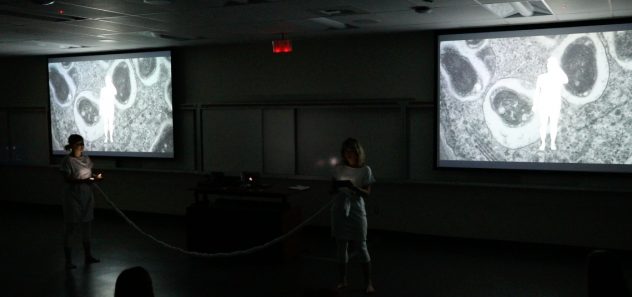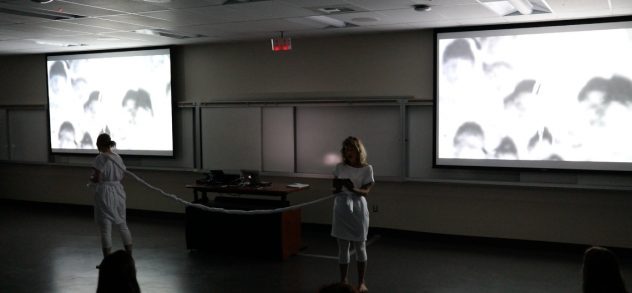Freya Zinovieff and prOphecy Sun share their experiences at ASLE; the Biennial Conference for the Association for the Study of Literature and Environment
Freya Zinovieff and prOphecy sun just returned from ASLE; the Biennial Conference for the Association for the Study of Literature and Environment, held this year at UC Davis, where they presented a performative version of our ongoing research project Mothering Bacteria. In this post, they share their experiences and tell us how it enriched their artistic and academic practices.
Can you tell us what is ASLE?
ASLE stands for the Association for the Study of Literature and Environment. It is one of the premier conferences in the Environmental Humanities. Truly interdisciplinary, the conference attracts professors, scholars, artists, and activists from environmental science, justice, academia, education, literature, art, and technology.
How was the experience at ASLE conference different or similar to other conferences that you have attended in the past – particularly those that are not humanities-based?
Firstly, we co-chaired a panel titled “Securing Paradise: Borders, Human and Nonhuman Intersections.” The panel was diverse and featured scholars from Harvard and Faculty Fellows from Environmental and Animal Studies at NYU.
Secondly, the conference program was extensive and diverse with many sessions, outings and social events overlapping one another. We decided to present our research in an interdisciplinary performative manner, which was quite experimental, in both the performance itself and the pedagogical process around the presentation. We also had to be strategic and prioritize our time between research, connecting with mentors and peers, rehearsing and practising the presentation, and preparing for our panel facilitation.
What did you present in ASLE?
We presented a performative presentation titled Mothering Bacteria: Shifting Borderlands in Algorithmic Spaces. The work was an iteration of an ongoing research project between ourselves, Gabriela Aceves Sepulveda, and Steve Di Paola.
Inspired by an ongoing drive to complicate traditional academic formats, and explore the intersections of creative practice and research, the piece was an interdisciplinary adaptation combining audiovisual projections, butoh inspired movement, costumes, technology, and light.
We reassembled the room by moving all the chairs and tables to the edge of the room and created a larger performance space, demarcated by a semi-circle of chairs. We also placed a long white cord along the floor from one end of the performance space to the other. This instantly made space for something out of the ordinary to happen. We turned all the lights off too and performed the work lit only by the screens of our ipads and the flash and movement of the video behind us.

How was your experimentation with a performative delivery of a paper like and how did the audience respond to it?
As this was a completely new thing for us, and the rest of the conference presentations followed a traditional academic format, we were not sure what the response would be. However, the audience response was fantastic! The room became very silent when we performed, and the questions at the end were thoughtful and provoking. It actually made us reflect on how some presentations can be quite dry, so when you do something differently, it can be a welcome relief to the audience, and something that will stick in their minds.
How does this presentation relate to your practice as artists and scholars? Do you see these two practices as different or how do they come together?
This presentation relates to both of our practices in a multitude of ways. First, there was a ritualistic element to the way we conducted the performance. For example, from the placement of the chairs to the way, we used light, to the ritualistic movements we enacted with each other and with the long cord that connected us. And lastly, to the way we alluded to the agency within the digital technologies that we used by lighting our bodies with them. In both the written and performative element of this work, we also aimed to generate space for other voices and open up a discourse around power and community making practices.
Freya: While this is unlike anything I have done before, my art practice is very much about ritual, both as a performance, but also as a way to honour the material agency of the tools I use to create work and the final product. The work also relates to my scholarly practice, for its intent at generosity and inclusivity. My initial training as an academic taught me that hard critique is the way to get ideas across, and more, be valued as a scholar. While critique is obviously necessary in order to build our ideas into something original, I think there is space for more generosity in academic discourse. I am really inspired by the work of Donna Haraway, Eve Sedgewick, and others, who, through their writing, practice ways to celebrate rather than tear down. It is a completely different way of going about research, and I really liked how we cultivated this paradigm in all aspects of the work. The work relates to both parts of my research and creative practice. I am still finding ways to merge the two together, as for me they occupy rather different brain spaces. However, this work is a good attempt I think of merging the performative with the written.
prOphecy: My practice is interdisciplinary and I see these two practices as the same or mirroring each other. For example, I use a combination of ritualistic, improvisational, chance inspired reflections and sound and movement explorations to explore and realize moments. I mesh making-thinking-doing or research-creation approaches to explore and define new potent fields of possibility – where new propositions, materialist sensibilities, and alternative methods of inquiry can co-emerge and validate in-between, threshold moments of performance.
What did you learn from this experience?
We learned a lot about how to work together under pressure. We discovered that we have a great synergy when it comes to getting things done as a team and remaining flexible when the conditions are not as expected. For example, we had prepared to present a film in a room with one screen. However, our allotted room had two screens! So we improvised within the space we where given and made the best of each opportunity and challenge that developed. In the end, the presentation turned out better than we could have expected.
We also, due to unforeseen circumstances, had the opportunity to step into the role of chairing the panel. This was a very informative experience with regards to the best way to time presentations, questions and answers. It gave us both direct experience and fresh ideas about how to chair future panels, and again was a great exercise in how to collaborate.
What was the most inspiring thing about this conference?
The conference was hugely interdisciplinary, which meant that we were rubbing shoulders with scholars working in a variety of fields. One of the most exciting things about this was seeing how many people are thinking about the Anthropocene (used here as an umbrella term for the mass changes taking place to earth and its inhabitants, due to carbon-fuelled capitalism). And more, not just thinking about the Anthropocene but working to affect real change through their work and living lifestyles that represent a commitment to living ecologically.
It was also really inspiring to witness some of the scholar’s talks, whose work we have been reading about for so long. For instance, Ursula Heise, one of the scholars at the forefront of critical Anthropocene discourses was there talking about the cultural meanings of endangered species. Also Melissa K. Nelson, who gave an incredible talk about how Traditional Ecological Knowledge, can impart crucial practices for troubled times.


